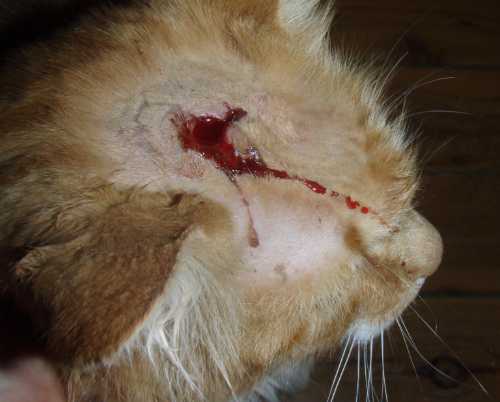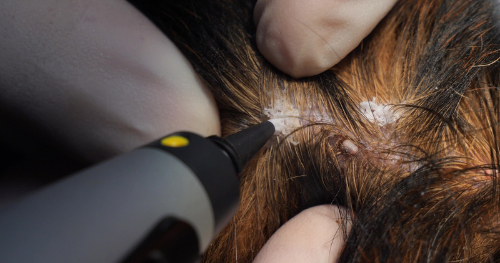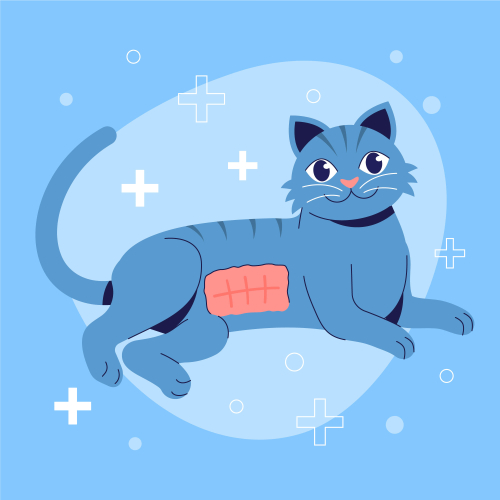Soft lump versus hard lump on your cat's chest
In this article we will only discuss the lumps originating from the soft tissues on a cat’s chest. A separate page is written about bony protrusions on the chest of cats. A lump originating from the soft tissues on your cat’s chest can also sometimes feel very hard. However, the difference between a bone-like lump and a hard lump originating from other tissues is generally quite easy to feel.
What types of lumps are possible on your cat's chest?
Abscess
In the vast majority of cases of a lump on your cat’s chest, this is caused by an abscess. An abscess is a pus-filled cavity under the skin that can appear in a fairly short period of time, usually about 2-3 days. The lump is usually painful and can also feel quite hard. Many cats also have a fever.
It occurs because there was a wound and a bacteria got under the skin through that wound. This usually occurred as a result of a fight with another cat. Don’t be alarmed if this lump suddenly opens and a lot of pus, blood and stench are released. It looks dramatic, but it’s actually good that the mess comes out. In the photo at the top of this page you see an abscess in the armpit of a cat. But usually you only see a thickening on your cat’s chest. Below you see an open abscess on the head of a cat. The lump on a cat’s chest has become much smaller after bursting.

Mammary gland tumor
In older female cats (and very rarely male cats), a mammary gland can form a tumor. You can recognise this as a lump on your cat’s chest at the location of a mammary gland. These can be benign, but unfortunately in cats they are usually malignant. So cancer. Since most cats with owners are sterilised, we don’t see this that often anymore. Sterilisation removes the sex hormones, making the mammary glands less likely to develop tumors. But if your cat has not been sterilised or was only sterilised at a later age, it may have a mammary gland tumor.
As long as no wounds are visible on this lump, a mammary gland tumor is painless. In that case, the lump is on the chest near a nipple. They often feel a bit lumpy, as if they consist of several lumps, although that is not always the case. The lump can usually also be described as fairly hard or firm. And you can feel a clear boundary between the lump and the surrounding skin.
A different kind of tumor
Other tumors on your cat’s chest are also a possible cause if there is a lump on your cat’s chest. However, this does not happen that often. It also occurs almost only in older cats. A tumor is an overgrowth of cells. It can therefore come from multiple types of tissues such as connective tissue, nerve tissue, muscle tissue, etc. Each tumor can be benign, but also malignant and can vary greatly in shape. They grow over a period of months to years and do not develop overnight.
A wart
This also mainly occurs in older cats. The top layer of the skin will bulge. It doesn’t hurt and looks a bit like a kind of mushroom or lump on the skin. Very occasionally they can become infected, but usually the skin of the wart and around it is normal. Below you see a lump on a cat’s chest that turns out to be a wart.

An insect sting
Cats are regularly stung by insects. Usually on the head or legs, but on the chest is certainly not rare. This lump on your cat’s chest feels soft and is not clearly defined around the edge. So the lump slowly blends into normal skin. Of course, the lump on your cat’s chest also appeared very suddenly and may be a little bit painful.
A cyst
Cats occasionally have a cyst. This is a cavity filled with body fluid. This may be a cyst filled with watery fluid or a cyst with sebum. In this case, the lump on your cat’s chest is usually about the size of a marble and with a little imagination you can feel that there is a liquid in it. The lump of a cyst on a cat’s chest also has a clear outline compared to your cat’s skin and is not painful. Although sometimes they do become infected and then they do become painful.
Inflammatory reactions
As a result of (mild) damage under your cat’s skin, a lump may develop on your cat’s chest. We often see this happen where a cat has received a vaccination or other injection. But this could also be the result of a less serious accident.
A lipoma
A lipoma is an overgrowth of fat cells. The fat cells multiply uncontrollably and then store fat inside. This lump has the same hardness as our own fat on our body and is generally clearly defined in the skin. They grow over a period of months and certainly do not occur in a day. They are not painful when we touch them nor do they feel hot.

What should you do if you notice a lump on your cat's chest?
A lump on your cat's chest that has recently developed.
First of all, it is important to ask yourself whether the lump may have been there for some time. Is the lump already half of an inch or bigger and are you pretty sure it wasn’t there before? Then it is probably an abscess, an insect sting or an inflammation. In that case, it is wise to measure your cat’s temperature. If he has a fever, there is probably an abscess. You do not need to treat an inflammation or insect sting. This usually resolves itself after about 7 days.
In the case of an abscess, the lump will soon burst. This releases a lot of pus, blood and especially stench. It looks dramatic! You can clean this with a gauze compress. You can remove the worst of the mess with dry gauze compresses and when you have almost removed everything you can wet the gauze compresses with some clean tap water or bottled water. It does not have to involve boiled and cooled water as there are already a lot of bacteria in the abscess. However, if you are in a country where the tap water is not so clean, it is better to use bottled water.
Once you have cleaned everything, drop some iodine solution into the opening. This causes bacteria to die. Twice a day you should squeeze the abscess to remove pus as much as possible and then put a few drops of iodine solution in it. If things do not improve after about three days, it is wise to visit your vet so that you can pick up a course of antibiotics. By the way, it can be quite painful for your cat if you squeeze out the abscess. But it is important that it is done.
A lump on your cat's chest that has been there for a while
Did the lump develop over weeks or months? And is your cat a senior? In that case there is a chance that it is a tumor. It is therefore important to take your cat to your vet. He or she can insert a small needle into the lump on your cat’s chest and remove some cells or fluid. A diagnosis can be made on this basis. However, sometimes it is necessary to use a laboratory. Your vet will tell you more about this. Fortunately, not all tumors are actually cancerous. Many of the lumps can simply be left alone as long as they do not bother your cat. In this way we often leave cysts, warts and lipoma’s in place. Only when it concerns cancer will you be advised to have it removed.
Good luck!
Hopefully you have found the answer to to what the lump on your cat’s chest can be. We wish you and your cat good luck!


